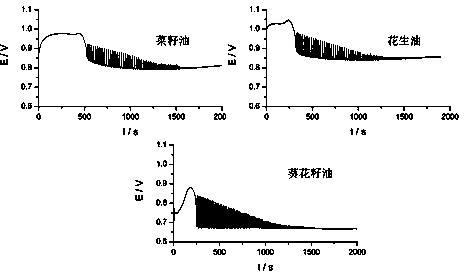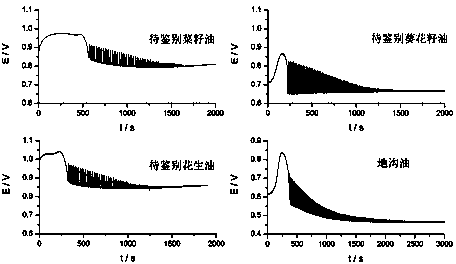Method for distinguishing edible oil from swill-cooked dirty oil by electrochemical fingerprints
A technology of fingerprint spectrum and edible oil, applied in the field of identifying edible oil and waste oil, can solve the problems of inability to detect the waste oil, the spectrum measurement is difficult to succeed, and the experimental steps are complicated, and the identification results are objective, accurate and reliable, and the detection cost is low. , analyze the effect of simple and fast
- Summary
- Abstract
- Description
- Claims
- Application Information
AI Technical Summary
Problems solved by technology
Method used
Image
Examples
Embodiment 1
[0025] The method for distinguishing edible oils of different varieties by using electrochemical fingerprints, comprising the steps of:
[0026] A. Obtaining fingerprints
[0027] Take 1.00mL rapeseed oil (Arowana), sunflower oil (Duoli) and peanut oil (Luhua) and 1.00mL0.25mol / L sodium dodecylbenzenesulfonate solution into the B-Z shaking system, control the solution temperature The temperature is 37.00±0.05℃, using platinum electrode as indicator electrode and double-salt bridge saturated calomel electrode as reference electrode, to obtain the change curve of potential with time, that is, to obtain rapeseed oil (Arowana), sunflower oil (Duoli) and the electrochemical fingerprint of peanut oil (Luhua), such as figure 1 Shown; where the B-Z oscillation system consists of 20.0mL2.0mol / LH 2 SO 4 , 20.0mL0.7mol / L malonic acid, 5.00mL5.0×10 -4 mol / LNaBr, 2.00mL0.01mol / L (NH 4 ) 4 Ce(SO 4 ) 4 and 1.00mL1.0mol / LNaBrO 3 composition;
[0028] B. Identification of samples to ...
Embodiment 2
[0035] The method for utilizing the electrochemical fingerprint spectrum to identify waste oil may further comprise the steps:
[0036] A. Obtaining fingerprints
[0037] Take 1.00mL rapeseed oil (Arowana), sunflower oil (Doli), peanut oil (Luhua), gutter oil, rapeseed oil to be identified, sunflower oil to be identified and peanut oil to be identified and 1.00mL0.25mol / L sodium dodecylbenzenesulfonate solution is added to the B-Z oscillation system, the constant temperature of the oscillation system is controlled to be 37.00±0.05°C, the platinum electrode is used as the indicator electrode, and the double-salt bridge saturated calomel electrode is used as the reference electrode. The change curve of rapeseed oil (Arowana), sunflower oil (Doli) and peanut oil (Luhua), waste oil, rapeseed oil to be identified, sunflower oil to be identified and peanut oil to be identified electrochemical fingerprints Atlas; the electrochemical fingerprints of waste oil, rapeseed oil to be ide...
Embodiment 3
[0045] The method for identifying different kinds of edible oils and gutter oils by means of electrochemical fingerprints comprises the following steps:
[0046] A. Obtaining fingerprints
[0047] Take 2.00mL rapeseed oil (Arowana), sunflower oil (Doli), peanut oil (Luhua) and gutter oil and 1.00mL0.5mol / L sodium dodecylbenzenesulfonate solution into the B-Z shaking system, Control the temperature of the solution at 50.00±0.05°C, use the platinum electrode as the indicator electrode, and the Ag / AgCl electrode as the reference electrode to obtain the change curve of the potential with time, that is, to obtain the electrochemical fingerprint of the edible oil sample; the B-Z oscillation system is composed of 20.0 mL2.0mol / LH 2 SO 4 , 20.0mL0.7mol / L malonic acid, 5.00mL5.0×10 -4 mol / LNaBr, 2.00mL0.01mol / L (NH 4 ) 4 Ce(SO 4 ) 4 and 1.00mL1.0mol / LNaBrO 3 composition;
[0048] B. Identification of samples to be tested
[0049] Extract characteristic parameters from the ele...
PUM
 Login to View More
Login to View More Abstract
Description
Claims
Application Information
 Login to View More
Login to View More - R&D
- Intellectual Property
- Life Sciences
- Materials
- Tech Scout
- Unparalleled Data Quality
- Higher Quality Content
- 60% Fewer Hallucinations
Browse by: Latest US Patents, China's latest patents, Technical Efficacy Thesaurus, Application Domain, Technology Topic, Popular Technical Reports.
© 2025 PatSnap. All rights reserved.Legal|Privacy policy|Modern Slavery Act Transparency Statement|Sitemap|About US| Contact US: help@patsnap.com



